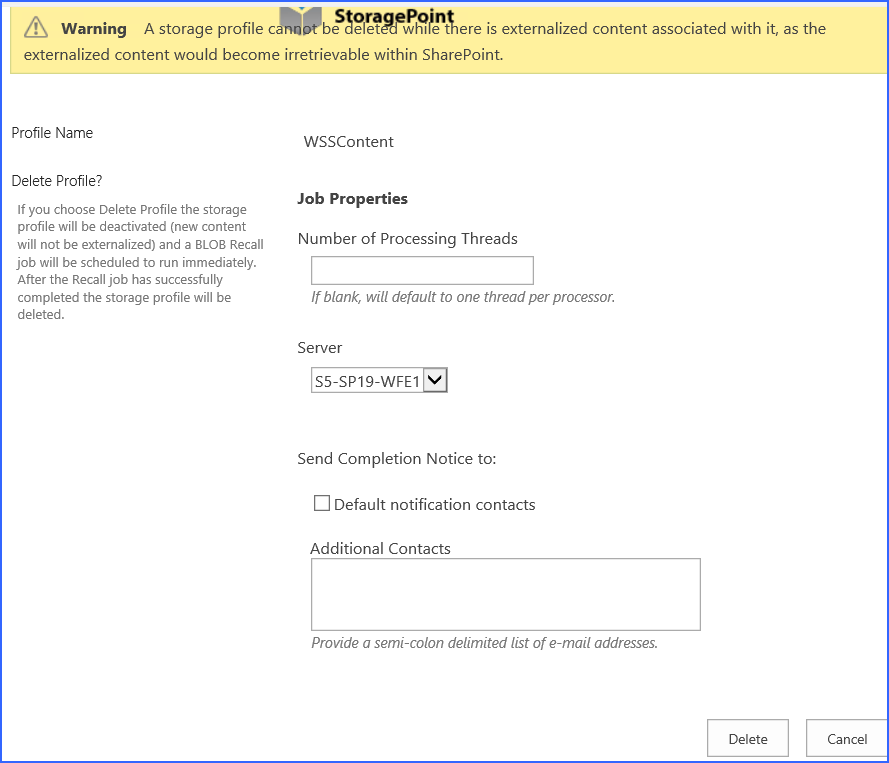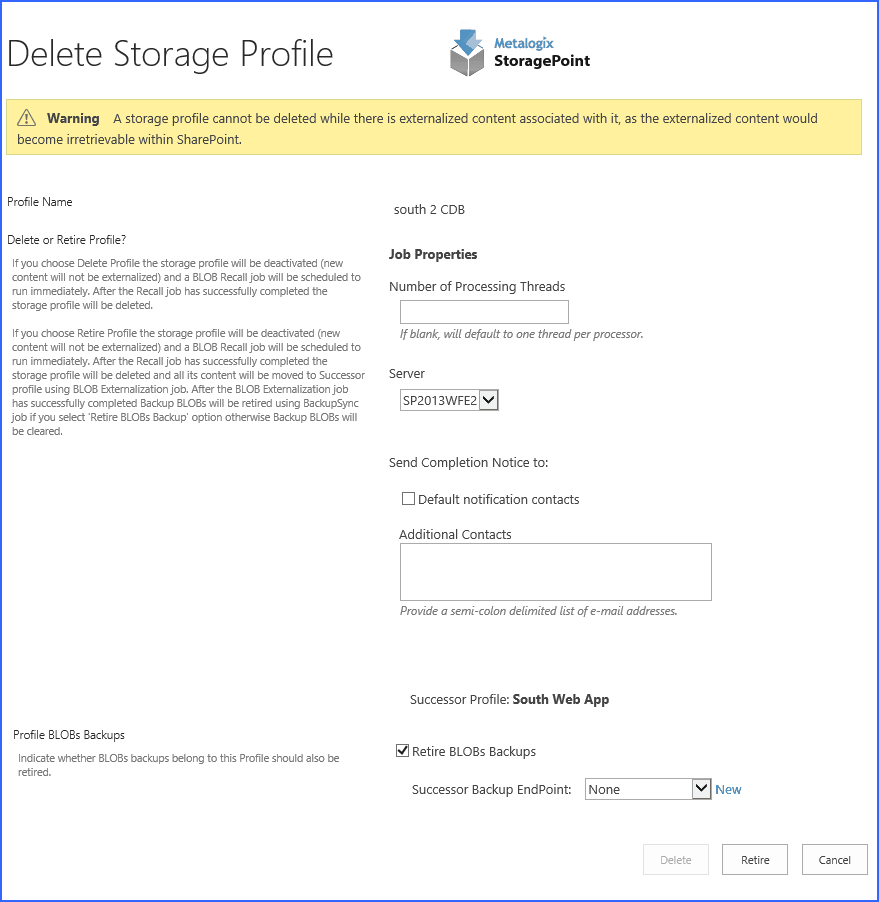Delete an Existing Storage Profile
While safeguards are in place to prevent externalized content from becoming irretrievable, deleting a storage profiles is still an operation that should be carefully planned and completed.
|
|
NOTE: Deleting the profile will automatically schedule a Bulk Recall and an Unused BLOB Cleanup job for the profile. |
|
|
NOTE: Deleting a profile with a librarian configuration is not possible. A warning will be displayed to delete the Librarian configuration first. Perform a Bulk Recall job for the profile, BEFORE deleting the librarian configuration. This will prevent errors when the bulk recall is performed at the time of profile deletion. |
Delete Versus Disable
If there was a File Share Librarian configuration that was associated with the profile, the content on that endpoint is also pulled into the content database by the bulk recall job when the profile is deleted. In this case, just change the Externalize Content BLOBS to No, instead of deleting the profile. This will leave the librarian file share intact.
It is strongly recommended that an Unused BLOB Cleanup Timer Job be run so that there is no confusion as to why there may be some BLOBs remaining after the Recall Job is performed. Once the Storage Profile is gone, there is no access to the Unused BLOB Cleanup Timer Job.
1.Click the name of the storage profile to open it.
2.Click Delete at the bottom of the page.
3.A deletion confirmation page is displayed.
4.Select the server on which to run the delete job.
5.Check the Default Notification Contacts checkbox, or enter other email addresses that should receive the completion notice.
6.Click Delete to continue with the deletion process or Cancel to return to the previous page.
A Recall job will be scheduled for the storage profile. Upon successful completion of that job the storage profile will be deleted. Until then, the storage profile will be in a deleting state and will not be editable. Additional timer jobs will also be unavailable for running or scheduling.
Retiring Storage Profiles
If there is a broader scoped profile available at the time of selecting Delete on the profile page, the only option will be to retire the profile, and select a successor profile. For example, if the profile being deleted covers a content database, but there is still an existing web application profile that covers that content database, the option to retire will be displayed but Delete will be greyed out.
If Retire is selected, the content will still be recalled, but a subsequent bulk externalization job will externalize the recalled content to the endpoint on the broader scoped profile. The Bulk Externalization job will need to be run manually if there are any errors in the Bulk Recall job. An Unused BLOB Cleanup Job will also be run for the retiring profile.
Backed up BLOBS can be moved to the Backup Endpoint of the successor profile, if the 'Retire BLOBs Backups' is checked, and there is a backup endpoint on the successor profile. (A backup endpoint can be selected for the successor profile at the time of profile retirement, using the dropdown.) They will be backed up by the successor profile's backup synchronization job, after they are externalized. Otherwise, backed up BLOBs from the retired profile will be cleared.
As with all bulk recall jobs, archived content will also be recalled. Archiving may need to be reconfigured for the successor profile, and it may be necessary to perform a Process Existing operation to re-archive content, if desired.
Storage Profile Timer Jobs
Storage Profile timer jobs process content based on the scope of the profile, rather than the entire SharePoint farm. They are the Unused BLOB Cleanup, BLOB Health Analyzer, BLOB Externalization, BLOB Recall, BLOB Migration, and Archive Aging jobs. This section will cover the purpose and configuration options for each. To review the summaries of each of these jobs, see Metalogix StoragePoint Timer Job Monitoring.
1.Click the Storage Profiles link on the Application Management page in SharePoint Central Administration.
2.Click the Jobs link in the Advanced Configuration column of the desired Storage Profile.
3.The Job Configuration page is displayed.
These timer jobs are profile-specific. To see the farm-wide timer jobs and reports, including System Health Report, go to General Settings.



